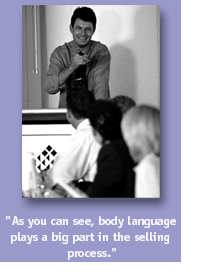
Reading Body Language
| ŌūÓšŗśŤ | ||||
| Sales.com | ||||
| Premium... | ||||
by Tom Hopkins
When it comes to recognizing body language clues from your prospective clients, you are like a detective in that you are asking questions. But it is so important that you not only listen to what they are saying and how they are saying it, but are also aware of some of the following clues. For example, when you want to be listened to, make strong eye contact. If you look at a person eye-to-eye, he or she will intently focus on what you are saying. Many people in sales donít have good eye contact and this is something very important.
 In
establishing eye contact, if you have two people at the table, be sure
you are not giving one of them too much attentionóor too much eye contact.
Spread the eye contact between both parties. Let me introduce you to something
I call ďsensory perception clues.Ē
In
establishing eye contact, if you have two people at the table, be sure
you are not giving one of them too much attentionóor too much eye contact.
Spread the eye contact between both parties. Let me introduce you to something
I call ďsensory perception clues.Ē
What should you do about it? Move to the next step in the selling process. There are times we can mirror our potential client, meaning that if he or she is in a certain posture, in order to relate to him or her we can move into that same posture. Donít over-do it though.
What should you do about it? Smile. Try to gain eye contact and reiterate the last point by asking if it bothers him or her. Talk about your desire to fulfill his or her needs again to make he or she happy.
What should you do about it? Again, mimic his or her actions as far as you are comfortable so the atmosphere is very relaxed. As a salesperson, it is important that you make people feel relaxed, comfortable and emotionally stable in your presence.
What should you do about it? Move closer to the final consummation.
What should you do about it? Continue with the presentation and test close.
As you can see, body language plays a big part in the selling process. Of course, we arenít experts in that field, but by studying our future clients and trying to understand their emotions through body language, we can help them overcome or work through any areas of concern they may be having, but not expressing verbally. Body language is only a minor part of the actual selling process though. Your words and phrases and your delivery and presentation style are a critical part of this business and should be honed to perfection through internalization and P.D.R. (practice, drill and rehearse)!
© by Tom Hopkins International, Inc.